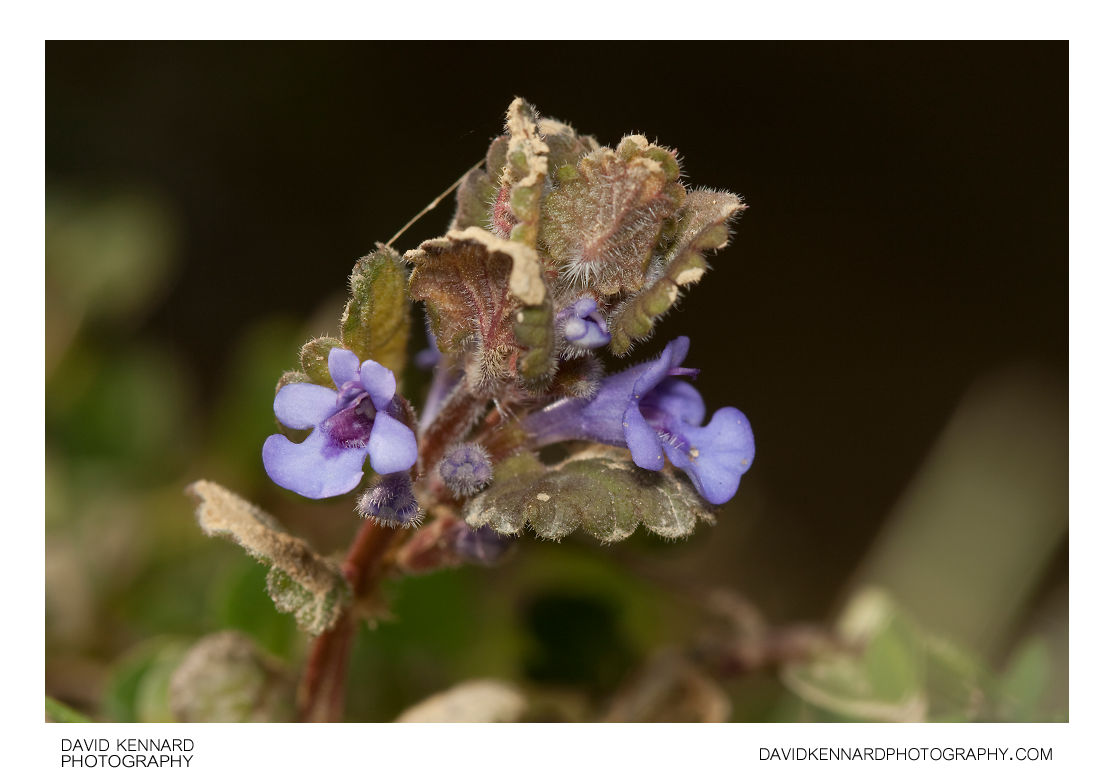Ground Ivy - Glechoma hederacea

Description
- Title:
- Ground Ivy - Glechoma hederacea
- Caption / Description:
-
Glechoma hederacea (syn. Nepeta glechoma Benth., Nepeta hederacea (L.) Trevir.) is an aromatic, perennial, evergreen creeper of the mint family Lamiaceae. It is commonly known as Ground-ivy.
Glechoma hederacea is native to Europe and southwestern Asia but has been introduced to North America and is now common in most regions other than the Rocky Mountains. Its common names include Alehoof, Creeping Charlie (or Charley), Catsfoot (from the size and shape of the leaf), Field Balm, Run-away-robin, Ground Ivy, Gill-over-the-ground, and Tunhoof. It is also sometimes known as Creeping Jenny, but that more commonly refers to Lysimachia nummularia. It can be identified by its round to reniform (kidney or fan shaped), crenate (with round toothed edges) opposed leaves 2–3 cm diameter, on 3–6 cm long petioles attached to square stems which root at the nodes. It is a variable species, its size being influenced by environmental conditions, from 5 cm up to 50 cm tall.
Glechoma is sometimes confused with common mallow or Malva neglecta, which also has round, lobed leaves; but mallow leaves are attached to the stem at the back of a rounded leaf, where ground ivy has square stems and leaves which are attached in the center of the leaf, more prominent rounded lobes on their edges, attach to the stems in an opposite arrangement, and have a hairy upper surface. In addition, mallow and other creeping plants sometimes confused with ground ivy do not spread from nodes on stems. In addition, ground ivy emits a distinctive odor when damaged, being a member of the mint family.
The flowers of Glechoma are bilaterally symmetrical, funnel shaped, blue or bluish-violet to lavender, and grow in opposed clusters of 2 or 3 flowers in the leaf axils on the upper part of the stem or near the tip. It usually flowers in the spring.
Glechoma thrives in moist shaded areas, but also tolerates sun very well. It is a common plant in grasslands and wooded areas or wasteland. It also thrives in lawns and around buildings, since it survives mowing. It spreads by stolons or by seed. Part of the reason for its wide spread is this rhizomatous method of reproduction. It will form dense mats which can take over areas of lawn, and thus can be considered potentially invasive or aggressive weed.
Glechoma is sometimes grown as a potted plant, and occasionally as a ground cover. A variegated variety is sometimes commercially available.
While often thought of as a weed because of its propensity for spreading, Glechoma has culinary and medicinal uses which were the cause of its being imported to America by early European settlers. The fresh herb can be rinsed and steeped in hot water to create an herbal tea which is rich in vitamin C.
Glechoma was also widely used by the Saxons in brewing beer as flavoring, clarification, and preservative, before the introduction of hops for these purposes; thus the brewing-related names, Alehoof, Tunhoof, and Gill-over-the-ground.
Glechoma has been used in the cheese making process as a substitute for animal rennet.
Glechoma hederacea has been used in the traditional medicine of Europe going back thousands of years. Galen recommends the plant to treat inflammation of the eyes, for instance. John Gerard, an English herbalist, recommended the plant to treat tinnitus, as well as a "diuretic, astringent, tonic and gentle stimulant. Useful in kidney diseases and for indigestion." It is also useful as a "lung herb". Other traditional uses include as an expectorant, astringent, and to treat bronchitis.
The essential oil of the plant has many potent medicinal properties; the plant has been used for centuries as a general tonic for colds and coughs and to relieve congestion of the mucous membranes. The plant has been demonstrated by studies in rats and mice to have anti-inflammatory properties. Many of the components of the essential oil have been studied individually and found to have various effects, including protecting against the formation of ulcers. One component, ursolic acid, was found in vitro to have antiviral activity against the Epstein-Barr virus.
Description taken from Wikipedia: http://en.wikipedia.org/wiki/Glechoma_hederacea
- Tags / Keywords:
-
- Biota
- Life
- Vitae
- Eukaryota
- Plantae
- Plants
- Magnoliophyta
- Flowering Plants
- Angiosperms
- Magnoliopsida
- Dicotyledons
- Lamiales
- Lamiaceae
- Mints
- Glechoma
- Glechoma hederacea
- Ground Ivy
Admin
- Date Original Photo Taken:
- Original File Name:
- _MG_8734-5.psd
- Event:
- Rating:
- ☆
- Date this image added/last updated on website:
- Original File Dimensions:
- 4272px x 2848px
- File Type:
- JPEG
- Color Mode:
- RGB
- Original Image Color Profile:
- Adobe RGB (1998)
Location
- Location Created:
-
- Sublocation:
- City:
- Market Harborough
- Province/State:
- Leicestershire
- Country:
- United Kingdom
- World Region:
- Europe
- Geo-location:
Rights
- Copyright Status:
- Copyrighted
- Licensing Status:
- Rights Managed
- Available for Editorial Use:
- Yes
- Available for Commercial Use:
- Yes
- Copyright Notice:
- © 2010 Dave Kennard
Camera Data
- Date Digital Resource was created:
- Shutter speed:
- 1⁄200 s
- Aperture:
- f/8
- Camera Model:
- Canon EOS 450D
- ISO:
- 100
- Exposure Compensation:
- 0
- Focal Length:
- 100mm
- Focal Length (35mm equiv.):
- Metering Mode:
- Multi-segment
- Flash:
- On, Fired
- Exposure Mode:
- Manual
- White Balance:
- Manual
- Light Source:
- Exposure Program:
- Manual
Additional shooting metadata
- Lens:
- Canon EF 100mm F2.8 Macro USM
- Filters used:
- Additional Optics used:
- Setup:
- Handheld, 2 shots
Canon MT-24EX Macro Twin flash with home-made diffusers
Post Processing
- Image Modified:
- Software used:
-
- Adobe Photoshop CS4
- Adobe Camera RAW
- Post Processing:
Images blended for focus in PS CS4
